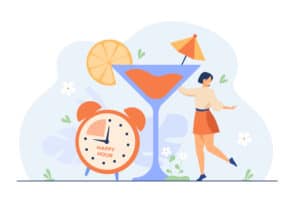
THE BOTTOM LINE:
- Naps can have many health-boosting benefits
- Learn how to nap strategically to avoid disrupting your sleep at night
- Naps aren’t for everyone
Catnaps, power naps, siestas – whatever you want to call them, naps are a popular choice for that midafternoon lull. With up to 70% of adults worldwide reporting not getting enough sleep each night, it’s no wonder naps are so popular. If you’re going to nap, though, it’s important to learn how to take your catnaps strategically.
So, like, are naps good?
They can be! While some people may find that naps can be disruptive to their nightly slumber, others find them to be a helpful supplement to daily well-being.
Sleep deprivation can make it feel like your brain is covered in cobwebs. When it comes to regaining your wits after sleep deprivation, naps are better than caffeine, have several health benefits, and can help boost creativity and productivity. This is why many companies have even begun installing nap spaces in their headquarters (feel free to pitch this idea in your next office meeting).
Knowing how to nap strategically can be an effective way to overcome some of the side effects of sleep loss and it gives you a reason to build a tiny bed under your desk.
The health benefits of a catnap
Superpowers: Even if you are well-rested, a strategically timed nap can boost mood, reaction time, and logical reasoning. This must be why cats are so powerful.
Makes you chill: Research on napping has found that a 60-minute midday nap can make you less impulsive and gives you greater tolerance for frustration. The same benefits weren’t found for people who engaged in a 60-minute midday relaxing activity.
Makes you smarter: We already know that sleep can help you learn better and consolidate memories, but as it turns out, naps have some of those benefits too! In fact, studies have found that you can get the same learning benefits from a 60 – 90 minute nap as from a full night’s slumber. If you’ve already had a full night’s rest, a nap can even compound these benefits. Naps boost attention, word recall, and memory formation. Napping appears to have the greatest impact on associative memory, which is the memory of how things are related (i.e., pairing a name with a face).
Improves immune system: When you don’t get enough sleep your body releases proteins called cytokines which cause inflammation and can lead to metabolic diseases. Losing sleep also reduces levels of natural killer (NK) cells. NK cells do important cleanup work like killing cancer cells and sleep is your key to restoring levels of NK cells every day. You don’t need a full night’s sleep to restore your body’s immune functioning, just a 30-minute nap was shown to restore cytokine levels to normal functioning after a period of sleep deprivation.
They can increase your alertness: For many people, taking an afternoon snooze can increase levels of daytime alertness. Researchers have found that a 10-minute nap is the sweet spot if you’re looking to perk up your energy levels and focus.
Risks of napping
Disrupted sleep: For some people, napping during the day can lead to difficulties falling asleep at night. This is especially true for people who struggle with insomnia or who nap for long periods of time.
Sleep Inertia: Waking up from a nap can make you feel groggy, disoriented, and mentally off. This can be due to rapidly exiting a deeper stage of sleep or factors such as sleep deprivation. Studies show in your brain, sleep inertia appears as a state between sleep and wakefulness. Impairment is generally temporary but can be very disruptive to productivity.
HOW TO NAP STRATEGICALLY
Follow these tips if you’d like to enjoy the benefits of napping without having it disrupt your sleep or your productivity:
1. TIMING IS KEY
The time of day you nap is one of the most important aspects of effective napping. Most people should aim to fit in their naps before 3 pm. Timing your nap between 1 pm to 3 pm would fit best into your natural circadian rhythm, as your body naturally experiences a midday lull during those hours. Napping in the evening has been shown to be associated with difficulty falling asleep and poorer sleep quality at night.
2. KEEP IT SHORT
Under normal circumstances, the most effective naps are 10-20 minutes. If you have a big event ahead of you or are already sleep-deprived, 30-40 minutes can do wonders. In extreme circumstances, 60-90 minute naps are fine, as long as they are earlier in the day. However, the longer you nap, the greater your risk of waking up during a deep sleep cycle and feeling like crap. As a general rule of thumb, keep naps around the 20-minute mark, as that will give you the health-boosting benefits without disrupting your sleep cycle later on or making you feel groggy.
3. KNOW YOUR CHRONOTYPE
Depending on your natural circadian rhythm and how you move through sleep cycles, napping may or may not be for you. Many people who identify as night owls generally find that they function best with an afternoon nap. Some people, however, tend to enter deep stages of sleep during naps which can leave them feeling groggy, disoriented, and drained after a nap. The best way to know is to follow guidelines for effective ways to nap and try it for yourself. Learn more about chronotypes and circadian rhythms.
4. MAKE IT A HABIT
There is evidence that people who nap regularly get more benefits from it. Whether they were already predisposed to napping well or got better with practice is up for debate. Regardless, people who nap regularly tend to stay in lighter sleep stages so that they can wake more easily. Infrequent nappers are more likely to slip into deeper sleep stages which leaves them feeling groggy rather than refreshed after a nap.
Unfortunately naps aren't for everyone, though.
Who should avoid naps?
Napping isn’t for everyone. For some people, it’s best to avoid napping altogether or wait until you’ve successfully implemented a regular sleep schedule (i.e. your circadian rhythm, is healthy). Here are people who should avoid napping:
1. Over-nappers
If you find yourself napping an hour or more each day you are in this category. Excessive daytime sleepiness and long naps may be a sign of a more serious health condition. You should talk to your doctor about your symptoms.
2. People who have trouble falling asleep
Napping can be a great boost, but if you already have trouble falling asleep or staying asleep, napping can make that worse. In order to regulate your sleep-wake cycle, it’s best to avoid naps. When you feel that mid-afternoon or evening lull, force yourself to engage in light activity or blast some upbeat music to get your energy levels up. It takes time to regulate your sleep-wake cycle but it’s worth the sacrificed naps.
3. Groggy monsters
If you find that naps always make you groggy, foggy, and “out-of-it”, you should probably just skip them. Replace naps with a 10-minute mindfulness meditation or simply sitting and listening to soothing nature sounds. You’ll get many of the restorative and relaxing benefits of napping without turning into a groggy monster.
4. Late nappers
Napping after 3pm is disruptive to your evening sleep. If you find yourself falling asleep in front of the TV in the evenings you may have to switch up your schedule. Try engaging in evening walks, light yoga, or another activity that keeps you stimulated.
Are you looking for a bizarre tip that seems counterintuitive but is actually kind of awesome? You’ve come to the right place.
Coffee naps
Fun fact! This is a totally legit and strategic way to nap and also gain the benefits of caffeine. Research has found that a caffeine nap may have cognitive-boosting benefits that are even greater than a normal nap.
Here’s coffee naps work:
Step 1: Drink coffee
Coffee takes around 15 minutes to enter the bloodstream and works its magic by blocking a chemical in your brain called adenosine.
Step 2: Immediately nap for 20 minutes
Sleep clears adenosine from the brain which means that coffee will be more effective at making you feel alert when you wake up.
Step 3: Wake up
When your alarm goes off you’ll be waking up just as that caffeine kicks in! As a bonus, your nap has cleared some adenosine from your brain which means caffeine will do an even better job of making you feel alert. Now that you’re awake, enjoy the perks (ha, perk, get it?).






